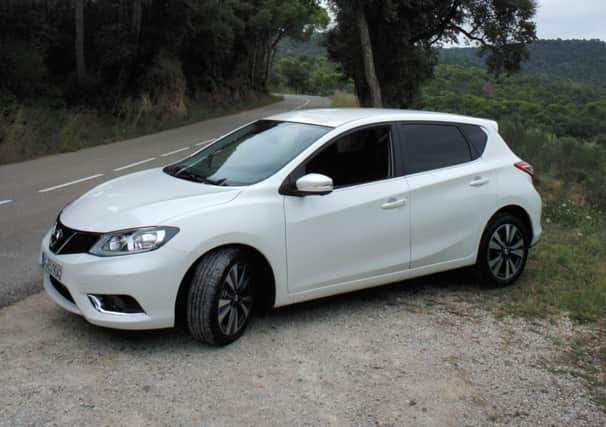First Drive: Nissan Pulsar


The Ford Focus, Vauxhall Astra, Audi A3 and Volkswagen Golf are icons in motoring – where performance, prudence and practicality converge.
It’s a daunting sector to break into, but, with the launch of the Pulsar this month, Nissan hopes to do just that. The firm hasn’t been seen in the sector for eight years since it closed the boot on the Almera, but it hasn’t exactly been kicking its heels since then, enjoying great success with the Juke and its bigger brother the Qashqai. In terms of size, the Pulsar fits snugly in between these two, plugging what Nissan sees as a gap in its portfolio.
Advertisement
Hide AdAdvertisement
Hide AdOf course, it’s unlikely the Pulsar will lure many A3 or Golf drivers, but it could have an impact on sales of the likes of the Hyundai i30 or Kia Cee’d. In such a competitive market, a unique selling point would come in handy, and Nissan has a few – masses of legroom, cheap entry prices and affordable hi-tech safety features – what Nissan likes to call “accessible technology”.
Car manufacturers always bang on about how their new model has more legroom compared to their rivals. Nissan is no different – proudly proclaiming that the rear-passenger legroom of 692mm is not only class-leading, but also better than the average D-segment car. But for once, these claims do actually translate into a real-life sense of more room in the back.
It’s a bit of a smoke and mirrors job, because the car doesn’t look terribly long (at 4,385mm, it’s just 2.7cm longer than a Ford Focus), the boot is a practical 385 litres (bigger than the Golf or the Focus) and this can of course be expanded by putting down the split rear seats. The legroom comes courtesy of the longest wheelbase in the C-segment – a whopping 2,700mm.
Marrying up with that extra space is a bundle of standard equipment usually found in larger, more prestigious cars. The entry-level Visia, which starts at £15,995, boasts a five-inch colour screen, steering wheel-mounted controls, Bluetooth and air conditioning.
The Acenta model, priced from £17,645, comes with the likes of automatic lights and wipers, keyless entry and, more significantly, Forward Emergency Braking – which as the name suggests, helps with some last-minute anchoring if it looks like you’re about to crash, and is also likely to help you out with your insurance bills.
Once you get up to Tekna level, which comes in at £20,345, you’ve got a colour reversing camera with clever software that gives you a bird’s-eye view when parking; Nissan’s unique moving object detection, which alerts the driver of errant children or pets running around nearby; lane departure warning and blind spot warning.
These aren’t new technologies, but they’re not often found in cars of this size and price. Such luxuries are slightly offset by a rather clumsily-placed central console and cheap leather-effect plastic straight out of the 1980s which has been used in the cabin.
Outside, the Pulsar looks the part. Its swooping lines and curves give it an athletic poise vaguely reminiscent of a new Golf, while the front and rear lights resonate with the X-Trail and Qashqai to remind you that this is definitely part of the Nissan family.
Advertisement
Hide AdAdvertisement
Hide AdUnder the bonnet, you have a choice between a 1.2-litre DIG-T petrol unit or a 1.5-litre diesel dCi engine – with either manual or automatic transmissions. The petrol engine generates 114bhp and 140lb ft of torque, the 1.5-litre dCi commonrail diesel unit 109bhp and 190lb ft of torque. A more powerful 1.6-litre petrol turbo will join the fray early next year, while the Pulsar’s sporty looks will tally up nicely with a boy-racer Nismo version too.
Of the two engines available now, the petrol was my pick – it’s more responsive, quieter and a little more fun, although both engines perform solidly and others might prefer the heavier presence the diesel has, because the steering can feel a little light.
The Pulsar feels well grounded, but the overall driving experience is unlikely to either alarm or excite anyone too much. That’s a diplomatic way of saying it’s boring, but that’s exactly what some C-segment buyers are looking for. Me? I’ll hold out for the Nismo version, I think.
VITAL STATS
Car Nissan Pulsar 1.2 DIG-T
Price From £15,995
Engine 1.2l turbo petrol, 3cyl, 114bhp, 140lb ft
Performance Max speed 118mph; 0-62mph 10.7s
Economy 56.5mpg
CO2 emissions 117g/km